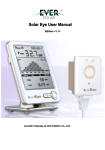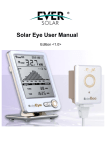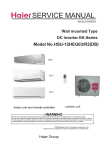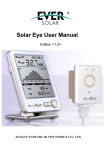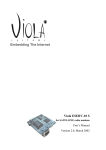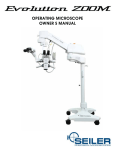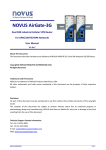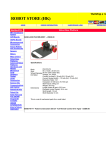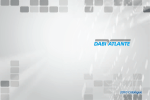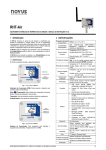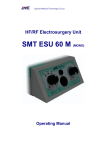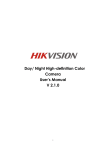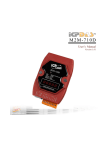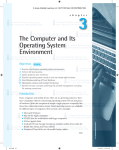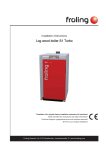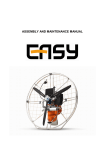Download Mantis-flightinstruc..
Transcript
-1- AIRGATECZ FLIGHT AD OPERATIO MAUAL Mantis 3 W130 Airgate cz, průmyslový areál Přerovských strojíren, objekt č. 6050-49, 750 00 Přerov, Czech republic, Petra Ivanová (English speaker) Tel.: +420 777 810 328, e-mail: [email protected] Jiří Kousal Tel.:+420 605 163 755, e-mail: [email protected], www.airgate.cz -2- SLZ Data – Mantis 3 W130 Registration mark OK- Inspector Technician Registration book Kind of PPG Landing gear Engine Propeller ame Firm Serial umber Harness Standby parachute ame, type Manufacturer Serial umber Year of production Parachute glider Take-off weight Minimum Maximum PG o.1 PG o.2 PG o.3 PG o.4 Landing gear weight including accessories without fuel and fillings : kg Owner’s/operator’s data Owner from - to Operator from - to ame/designation ame/designation Address Address Personal Ident. o. Personal Ident. o. Ident. o. Ident. o. Data about change of owner/operator Owner from - to Operator from - to ame/designation ame/designation Address Address Personal Ident. o. Personal Ident. o. Ident. o. Ident. o. Signature of inspector- technician, stamp In Date Airgate cz, průmyslový areál Přerovských strojíren, objekt č. 6050-49, 750 00 Přerov, Czech republic, Petra Ivanová (English speaker) Tel.: +420 777 810 328, e-mail: [email protected] Jiří Kousal Tel.:+420 605 163 755, e-mail: [email protected], www.airgate.cz -3- User manual for paramotor Mantis 3 W130 This manual has been issued by the manufacturer of SLZ. All records must be legible and indelible. All pages must be included. This manual is a part of technical documentation. Records of the total airtime and number of flights have to be kept in the new Flight Manual. The last and obligatory bulletin is getting ready. Enter only verified and measured data into technical – operational data. The manufacturer of SLZ, who is the owner of this manual, is responsible for keeping records accurate and up to date. EXPLANATORY NOTE: SLZ – abbreviation for sport flying machine Important notice If there are changes regarding regulations or the structure of SLZ, there will be a new bulletin (for example in the PILOT) indicate these changes. Each owner is responsible to make the change and mark this change in certain part of the manual. The owner, each operator and the pilot must be acquainted with this manual. This product is not subject to the approval of the Civil Aviation Authority of the Czech Republic and is operated to own risk of the user. Intentional spins, falls and acrobatics are prohibited. All structural changes of the SLZ against the status, for which the technical certificate has been issued, must be approved by the inspector-technician who has SLZ in his register. Each damages of the SLZ must be reported to the given inspector-technician. He will recommend the way of reparation; he will supervise the execution of reparation and will perform a technical inspection after the reparation. The record is made in SLZ documentation. Operating of the directional controls and controlling of the SLZ Aerodynamic control The SLZ turns to the left side by pulling left hand side rope and it turns to the right side by pulling right hand side rope. The angle of the start of the canopy increases by pulling both control ropes simultaneously and the flight speed decreases. Inertial control Once the pilot moves its weight in the seat to the left side, the SLZ turns to the left and vice versa. The SLZ turns to the right side being trimmed for the straight level flight at 50 % of the engine power by increasing the speed. The SLZ turns to the left side by decreasing the engine speed. Change of pilot’s position and increase of the speed by means of speed system, see fig. Flying positions a), b), c) The SLZ is equipped with double cross-bar for control and steering by legs. The paramotor unfold automatically itself into to flying position immediately after the start as a Airgate cz, průmyslový areál Přerovských strojíren, objekt č. 6050-49, 750 00 Přerov, Czech republic, Petra Ivanová (English speaker) Tel.: +420 777 810 328, e-mail: [email protected] Jiří Kousal Tel.:+420 605 163 755, e-mail: [email protected], www.airgate.cz -4consequence of the pressure of the pilot’s full weight in the harness (fig. A). Pilot’s legs sustain in this basic flying position partly push forward in case of repeated contact with the ground during the start or landing. A pilot moves his/her heel into the cross-bar number 1 (only in safe height) when he /she wants to turn the body to the aerodynamic preferable position. A pilot change himself/herself into the horizontal position when he/she presses with full power on the cross-bar by both legs. This position is fixed automatically by moving gliders (on spacers) into ends of grooves. If a pilot releases cross-bar number 1, his/her body get stabilised in flying position. (fig. B). A pilot can increase the speed of SLZ by adding of cross-bar number 2 (speed system) and by pressing of both cross-bars simultaneously. This causes decrease in angle of canopy and simultaneously turning of pilot’s body into the horizontal flying position (fig. C). If a pilot wants to change his position, he/she makes named steps in opposite direction. The speed of SLZ is decreased by releasing of both cross-bars. This causes increase in angle of the canopy and simultaneously turning of pilot’s body to the flying position (fig. B). When a pilot releases the cross-bar number 2 and press the cross-bar number 1, he/she gets immediately in flying and landing position (fig. A). At this time the tension is released in gliders locks of spacers, a pilot can lock-off the safety-fuse by thumbs and a pilot move back gliders by releasing cross-bar number 1 in its flying position (fig. A). A pilot is ready for the landing manoeuvre. WARNING!!! As a consequence of pilot’s turning and moving of the main snap hook of the sling, the height of the sling will change as well as the position of the steering. Therefore a pilot must pay the utmost attention to changed length of the steering, so that the canopy is not stalled unintentionally!!! Engine throttle control The throttle control handle is positioned in the left hand. The power is increased by depressing the lever and vice versa. Ignition switch and starter button The handle is equipped with two buttons. The red “switching off” button (at the thumb of left hand) serves to shut down the engine. The black button “starter” serves to start the engine. It is at the opposite end of the handle. Airgate cz, průmyslový areál Přerovských strojíren, objekt č. 6050-49, 750 00 Přerov, Czech republic, Petra Ivanová (English speaker) Tel.: +420 777 810 328, e-mail: [email protected] Jiří Kousal Tel.:+420 605 163 755, e-mail: [email protected], www.airgate.cz -5Fuel indicator and indication of the charging during a flight The throttle handle is equipped with six LED diodes. Five diodes light when is the tank fuel. Diode lights switch off one by one when the amount of the fuel decreases. When the last diode twinkles, it signalises that there is enough fuel for last 10 minutes of a flight. The six-diode indicates the process of the charging in this way: -continual light: charging -twinkled light: full charged battery -light diode does not light: fault of the charging; in this case, a pilot has last 20-50 minutes for the flight and landing (It depends on how the battery is charged). The main switch The rocker-type selector switch is placed on the upper cover of the ignition and battery. The electronic ignition of the engine, fuel indicator and starting relay are started by turning on the rocker-type selector switch. All function mentioned above are shut down by turning off the rocker-type selector switch. By this is possible to shut down the running engine. Rescue system The standby parachute is positioned on the breast of the pilot in a container. It is thrown-off by a right hand. Technical parameters Weight without fillings Paramotor without harness, with electrical starter and propeller Maximum take-off weight 23 kg 150 kg Dimensions Paramotor in transport packing 50 x 60 x 120 cm Diameter of protective frame 135 cm Airgate cz, průmyslový areál Přerovských strojíren, objekt č. 6050-49, 750 00 Přerov, Czech republic, Petra Ivanová (English speaker) Tel.: +420 777 810 328, e-mail: [email protected] Jiří Kousal Tel.:+420 605 163 755, e-mail: [email protected], www.airgate.cz -6Engine Two-stroke spark-ignition single cylindered W130, membrane carburettor Walbro, tuned exhaust with extra silencer Volume of cylinders 130 ccm Max. take-off power 24 hp Power unit weight, with electric self-starter 13,5 kg Fuel petrol 95 octane Average consumption 2,5 l/hr Oil (recommended for low speed engines) filled synthetic Mixing ratio 1 : 50 Ignition processor Reducer 1: 3,1 Fuel tank volume 11,5 l Propeller wooden Ø 120 mm Electronic recharging during a flight 5A Rescue parachute system Type, producer Way of activation Max. sinking speed at max. take-off weight Positioning Battery Type Capacity Voltage Ignition/ charging Processor, without contact with gradual control of the pre-ignition depending on engine speed Energy consumption during running of the engine Controlled charging current Starting circuit Starting current (to start only till 6 s, 15 s cooling) Efficiency ring / easy fly manual 7 m/s 150 kg on the pilot’s breast NiCd 2.5 A/h 14,4 V E-power max 1 A max 3,5 A 200A 98% Pre-flight preparation Assembling of the paramotor Place carbon spacers into operational position after opening the transport bag and connect spots of turning by mounting and tightening up the screw M6. Tightening up the screw M6 must let spacers freely turn around. When the motor is prepared in this way, take the motor out of the transport back and put it on its bases. Handle beam of rays with strings and Airgate cz, průmyslový areál Přerovských strojíren, objekt č. 6050-49, 750 00 Přerov, Czech republic, Petra Ivanová (English speaker) Tel.: +420 777 810 328, e-mail: [email protected] Jiří Kousal Tel.:+420 605 163 755, e-mail: [email protected], www.airgate.cz -7connect them with the frame of the motor according colours. Insert arches of protective ring of the propeller according to the colours in between ends of rays. Arrange the position of strings and hang the ending hangings in the shape of L on spines of the frame of the motor. Tighten strings by hanging tightening tubes into hooks. Propeller Position the propeller on the reducer with the middle hole on the distance ring. Place the propeller flange and secure it by means of six fastening screws. Tighten screws by the attached wrench in the cross direction by a moment of about 1 kg/m. (Do not damage the propeller body by strong tightening.) Mount the propeller properly, i.e. its leading edge towards the engine. It is recommended to rotate one turn of the propeller manually before the start and insure in this way that the propeller is positioned correctly. Harness and its adjustment according to a pilot’s height The harness is equipped with carrying girths; see Fig. 1, 2 (red, green, yellow). All these thrust of the harness are converged into the eye designed for connection with the canopy. Red thrusts LP are interconnected by a belly girth, buckle and a trimming for tension of the girth. The foot girths are executed in the same way. The shoulder girths with trimming are interconnected by means of breast girth, buckle and a trimming for tension. A pilot is fastened into the harness by shoulder girths and breast girths. Shoulder girths are designed for carrying the paramotor on the ground. The breast and shoulder girths are adjusted so that the carbon contact back is seated by its cut-out to shoulders and back of a pilot. And consequently the weight of paramotor is distributed into shoulders and back. Then it is necessary to tighten foot girths and adjust the tension of the green thrust, see Fig. 1. The setting of the distance of the green thrust influenced directly the perpendicularity of the propeller thrust in all flight positions of a pilot. Fig. 1 Fig. 2 FLIGHT FLIGHT CROSS-BAR POSITION Airgate cz, průmyslový areál Přerovských strojíren, objekt č. 6050-49, 750 00 Přerov, Czech republic, Petra Ivanová (English speaker) Tel.: +420 777 810 328, e-mail: [email protected] Jiří Kousal Tel.:+420 605 163 755, e-mail: [email protected], www.airgate.cz -8The transverse girth of the trimming of the straight flight has to be released before the start and landing! Tighten up the girth during the flight if it is necessary. The girth is for the stabilization of the overturning moment of the propeller. This girth is buckled last and is used for straight flight adjustment at various loading engine levels. After attachment of a pilot to the canopy, move karabiners of the positioning system to the eye of the canopy along with main carbines, see the figure. Pre-flight inspection Frame Strings Propeller Engine Reducer Equipment Tank Seat Rescue system Oil Petrol Engine test Pilot Instruments Parachute entireness, assembly, securing entireness, tension orientation, tightening of screws, entirety silent blocks, carburettor fastening, exhaust fastening screws, belt tension entire status, fuel inlet, electrical contacts, switches, spark-plug cable leak proof, cover tightness connecting points, pilot, parachute connection, locking pins, handle correct mixture sufficient fuel for the planned flight high speed, idle run, switching-off crash helmet, suitable dress and footwear, gloves altimeter, rate of climb indicator - setting and checking of proper function canopy, ropes and loose ends Engine test ever start the engine without the propeller! Turn on the main switch placed on the cover of the ignition. Before the start of the cold engine Set the throttle at the full power in that way that the constricting flap of the carburettor opens. Enrich the mixture of the fuel by 3-5 multiple injection of the fuel with help of pump on the cover oh the ignition. Set the throttle on 20% power. Press the black button on the throttle handle. At this time, when the motor starts, release the throttle slowly to prevent high speed of the motor and release the button of the starter. Airgate cz, průmyslový areál Přerovských strojíren, objekt č. 6050-49, 750 00 Přerov, Czech republic, Petra Ivanová (English speaker) Tel.: +420 777 810 328, e-mail: [email protected] Jiří Kousal Tel.:+420 605 163 755, e-mail: [email protected], www.airgate.cz -9Before the start of the warm engine Set the throttle on 10% of the engine power. Press the black button on the throttle handle. At the moment when the engine starts, release the throttle smoothly so that the engine is not revved up to the high speed and release the starter button. Standard flight procedures Take-off Spacers are oriented towards the ground when a pilot carries the paramotor. Spacers do not restrain the pilot in his movement. The propeller thrust is sloped slightly towards the ground at the moment of the run and enables the natural position of the pilot’s trunk. Once unstuck, the reels move slightly forwards due to tension of foot girths and the pantographic spacers start optimising the thrust direction of the power unit. All other positions of a pilot influence positions of legs and this will change the position of reels and consequently the thrust direction of the power unit. All this happens without any attendance of a pilot who may pay his attention to the control of the paramotor. Unless the pilot steps on the cross-bar he remains in the position enabling the repeated ground running. When the safe height is reached, it can be stepped on the cross-bar, which is not connected into the accelerator of the canopy (the wing does not change the angle of attack). Consequently a pilot can move into the more advantageous, aerodynamic and more comfortable position. Landing Upon the landing manoeuvre a pilot proceeds as follows: 1. If a pilot stand in the speed cross-bar and bushings are locked in their end position, a pilot has to: a) Leave the speed cross-bar and move his/her legs to the positioning cross-bar b) Press fully the positioning speed bar ( it is possible to land relatively safely in the case of emergency with secured bushings at their end position, but it is recommended to press fully the positioning speed bar for the right function of the harness) c) Release the thrust in trips of bushings, pilot can lock-off them by safety-fuse by thumbs and in this way a pilot allows their come back to the starting and landing position. Take out legs from the seat of the harness and be ready to the landing manoeuvre. 2. In case a pilot does not stand in the speed cross-bar: Proceed further in the way as shown under item b). on-standard flight procedures In-flight engine failure (up to the height of 200 m) • • • Transfer the SLZ into the gliding flight At a small height, land in the flight direction – correct the flight to avoid obstacles At the higher height, land into the space without obstacles, if possible, in the direction against the wind Airgate cz, průmyslový areál Přerovských strojíren, objekt č. 6050-49, 750 00 Přerov, Czech republic, Petra Ivanová (English speaker) Tel.: +420 777 810 328, e-mail: [email protected] Jiří Kousal Tel.:+420 605 163 755, e-mail: [email protected], www.airgate.cz - 10 In-flight engine failure (height above 200 m) • • • • Fire • • Transfer the SLZ into the gliding flight Check the fuel quantity In the case the failure was caused by the discontinued flow of fuel, try to start the engine again If the engine fails to start or the height drops less than 200 m above the ground level, then select a suitable landing surface and proceed as in the previous case Switch off the ignition and do not try to start the engine once again Land as quickly as possible Vibrations • set the engine speed into such mode where vibration are the smallest • land as soon as possible • if vibration increase, turn off the engine immediately Application of rescue system • Turn of the ignition in case of emergency upon definitive loss of control over the parachute, grasp the releaser of the standby parachute, release it by pulling and throw it askew from a pilot’s body in the direction of pilot’s rotation. Adjustment and maintenance of power unit Engine running-in Engine running-in is very important because of two reasons: 1) proper settlement of all parts of an engine 2) decisive influence to the total service life of an engine We recommend to let the engine run for about 1 hour on the ground at medium speed and from time to time to increase the power to full speed for a period of 1-2 seconds. Then return back to medium engine speed. Towards the end of this hour let the engine run at the full speed for about one minute. It is important to keep the mixing ratio for running-in, i.e. 1: 30. After such running-in the engine is capable for flying. It is not appropriate to fly for a period of following 5 hours at a full power for a period longer than 5 minutes. After running-in it is possible to begin mixing in the ratio of 1:50. Fuel and oils We recommend using fully synthetic oils for lower-speed motors. These quality oils will ensure you the maximum service life of an engine and its minimum carbonisation. Airgate cz, průmyslový areál Přerovských strojíren, objekt č. 6050-49, 750 00 Přerov, Czech republic, Petra Ivanová (English speaker) Tel.: +420 777 810 328, e-mail: [email protected] Jiří Kousal Tel.:+420 605 163 755, e-mail: [email protected], www.airgate.cz - 11 Tensioning of the reducer belt Steps of tensioning of the reduce belt are: loosing up safety screw M6, turn with the help of iambus screw the cracked shaft the wheel of reducer into the position when the reducer belt is strained up in required way (with the pressure on the belt in the middle of wheels cca 5-7kg makes drop about cca 3-5mm), tighten up the safety screw M6. Propeller maintenance If you discover minor scratches on the propeller, treat them to prevent humidity penetration into blades. It is necessary to balance the propeller during the reparation of larger cracks. Applying of varnish and paints will unbalance the propeller and increase vibration during the running of the motor. Regular maintenance Part inspection replacement spark plugs reducer belt engine silent blocks exhaust silent blocks 10 hr before flight before flight before flight 50 hr / year 100 hr / 2 years 100 hr / 2 years 100 hr / 2 years It is necessary to fix or change given part before the next flight in the case of damage of any part of SLZ. Airgate cz, průmyslový areál Přerovských strojíren, objekt č. 6050-49, 750 00 Přerov, Czech republic, Petra Ivanová (English speaker) Tel.: +420 777 810 328, e-mail: [email protected] Jiří Kousal Tel.:+420 605 163 755, e-mail: [email protected], www.airgate.cz - 12 - Summary of done services Survey of prescribed inspections performed, repairs, OK replacement of important parts etc. Action (reason) Date of performance Performed at number of Signature flight hours flown (hrs.) executed/checked Airgate cz, průmyslový areál Přerovských strojíren, objekt č. 6050-49, 750 00 Přerov, Czech republic, Petra Ivanová (English speaker) Tel.: +420 777 810 328, e-mail: [email protected] Jiří Kousal Tel.:+420 605 163 755, e-mail: [email protected], www.airgate.cz - 13 - Storage into the transport packing Prepare the transport packing to put the paramotor (without the protective cage) in. Put on the protective frame (OR). Dismantle spacers and tilt their ends. Place loose spokes and bows into casings and insert them into free space of the transport packing. Close the transport packing. Principles of long-term storage • • • • Drain out the fuel Disconnect the battery Perform conservation of the combustion space of the engine Store the propeller Basic equipment • Folding paramotor with electric starter and battery charging during the flight • Universal harness, buckles, snap hooks, positioning equipment, speed cross-bars • • • • Wooden propeller Ø 120 mm, screws for tightening Battery NiCd 2,5A/h Transport packings Flight and Operation Manual / Warranty certificate Airgate cz, průmyslový areál Přerovských strojíren, objekt č. 6050-49, 750 00 Přerov, Czech republic, Petra Ivanová (English speaker) Tel.: +420 777 810 328, e-mail: [email protected] Jiří Kousal Tel.:+420 605 163 755, e-mail: [email protected], www.airgate.cz - 14 - Daily operation records Date Place of Daily take-off and o. of take- Flight landing offs duration OK Total o. of take-offs Flight duration otes as to the flight, defects, repairs, consumption etc. Airgate cz, průmyslový areál Přerovských strojíren, objekt č. 6050-49, 750 00 Přerov, Czech republic, Petra Ivanová (English speaker) Tel.: +420 777 810 328, e-mail: [email protected] Jiří Kousal Tel.:+420 605 163 755, e-mail: [email protected], www.airgate.cz - 15 - Warranty Certificate – Mantis 3 W130 Serial Number:………………………………… Registration mark:………………………………. Engine:………………………………………… Warranty for the paramotor produced by the company AIRGATECZ covers all defects of all parts of the paramotor including the engine and the harness for a period of 24 months. The warranty does not include defects caused by improper handling or due to physical damage. The warranty becomes effective on the date of signature by both parties. This product is not subject to the approval of the Civil Aviation Authority of the Czech republic, and is being used to the own risk of the owner or operator. Date……………………………Seller’s signature ……………………………. The buyer confirms by his signature that he has been acquainted with the proper using of the paramotor and that he will inquire about whatever changes or issued Bulletins by the Manufacturer in regard to this product. Buyer’s signature............................................... Airgate cz, průmyslový areál Přerovských strojíren, objekt č. 6050-49, 750 00 Přerov, Czech republic, Petra Ivanová (English speaker) Tel.: +420 777 810 328, e-mail: [email protected] Jiří Kousal Tel.:+420 605 163 755, e-mail: [email protected], www.airgate.cz















